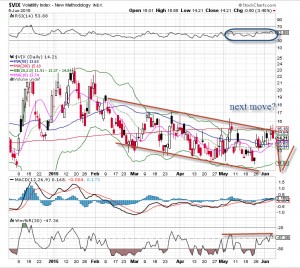Historically, summer trading ushers in a time of low volatility and very little interest from investors and traders. As a result of the thin liquidity, markets tend to make sharp and jagged moves. This year, we also have markets at/near all-time highs, and nobody truly wants to get off the train. This make options trading difficult, but I’ve often seen opportunities arise when traders are looking the other way. To paraphrase Robert Frost, “The road less traveled makes all the difference.”
Despite a rather mellow trading environment during the summer, we typically have some sort of summer rally occur. With very little fear in markets today (the VIX is under 15% and has been well under 20% since early February), option prices are cheap – even if trades are tough to find. Recently, the VIX came down to 12%, an area previously seen as a reversal (see chart). However, that tends to be a good contrary indicator. Hence, buying some puts as protection against your portfolio makes for one of the better summer options trading strategies.
prices are cheap – even if trades are tough to find. Recently, the VIX came down to 12%, an area previously seen as a reversal (see chart). However, that tends to be a good contrary indicator. Hence, buying some puts as protection against your portfolio makes for one of the better summer options trading strategies.
If we do have a market rally during the summer months, then hooray for our long plays. But, what if that doesn’t come to pass? What happens if some unforeseen event hits the market hard, or a Fed rate hike starts to get everyone uptight? There is quite a bit of downside action to be had if the market leans in that direction – but your portfolio needs to be protected.
Rising fear levels tend to increase the premium for options, especially put options. Puts increase in value as a stock or index declines, often dampening the volatility of a long-only portfolio (long call options or just stock). The beauty of put options is leverage, because very little up-front cash is needed to protect your stock positions. I nearly always have some put protection in place, just in case something in the market goes awry.
One of my favorite options trading strategies is buying straight puts on one or two indices. These are in some of the most liquid names (easier to get in/out of), and they closely track the underlying stocks. My first preferences are the index ETFs (exchange-traded funds): SPY, IWM, DIA or QQQ. I choose the ETF that seems to be weakest or provides the best protection against my holdings with strong correlation.
We can complicate this strategy with several different structures that reduce risk, but with volatility so low, option prices are not expensive. Ideally, to protect a portfolio of stocks, I will buy puts that are 1-2% of the value of my overall portfolio. Hence, with a $100K account, I may have $50K in option or stock plays outstanding and $50K in cash. To protect the “invested” side of my portfolio, I may buy $800-1,200 worth of puts (generally weekly options if they are offered; I just keep rolling them over).
If the market rises I will lose money on these plays, but if done right, my long portion should overcome the losses, my overall volatility will be dampened, and my profit/loss will be lower, but I will happily give up profits for some portfolio insurance. The alternative – losing large portions of a portfolio – is not a happy alternative.



















